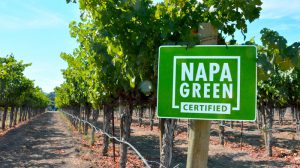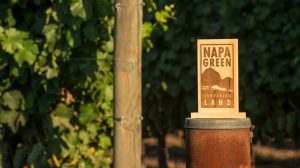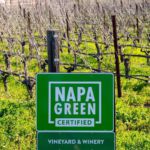
Credit: Napa Green / Facebook.com

Credit: Napa Green / Facebook.com
Napa Green: How One Sustainability Program Is Working to Save Napa Valley
- TAMARA GANE | vinepair |
- April 5, 2021
In 1998, California’s Napa Valley was grappling with an unpleasant reality. According to the Environmental Protection Agency (EPA), the Napa River was impaired by so much sediment and pesticides, the salmon and trout were dying. In response, Napa Valley Vintners, a nonprofit trade organization of area wine producers, banded together to implement standards and guidelines to protect the local ecosystem — establishing a fish-friendly program to eliminate harmful pesticides, manage erosion, and restore the rivers back to their previous health.
It wasn’t enough.
At the same time, a growing body of science surrounding climate change made it clear that unless changes were made sooner than later, the wine industry could be facing a future in which no one could grow grapes at all. In a place like Napa Valley, where 90 percent of the wineries are family-owned, this was an especially devastating possibility. Generations of hard work and tradition were at risk of being lost. Something had to be done. The Napa Valley Vintners may not have been able to change the rest of the world, but they did have the power to alter their own practices.
Over the next few years, the organization researched best practices and established a program that would eventually come to be known as Napa Green. The program offers two certifications. One is awarded to vineyards that demonstrate a focus on practices like managing erosion, reducing and eliminating harmful inputs, conserving water, and contributing to the health of the Napa River watershed. The other certification is for the practices of wineries themselves, including waste prevention, efficiency with energy and water, reduction of carbon footprint, and social equity.
Between the two certifications, Napa Green works with individual wineries and vineyards to develop customized plans for sustainability all the way from soil to bottle. The program is not one size fits all. Instead, it takes into account participants’ current practices in order to set ambitious yet tangible goals for improvement. Participants in the program are constantly pushed for advancement. In order to maintain their certifications, vineyards and wineries must be re-evaluated every three years and demonstrate improvement over past metrics.
Since the program’s inception in 2004, 657 Napa wineries and vineyards have obtained Napa Green certifications, covering more than 80 percent of Napa’s vineyard acreage. And participating wineries have discovered that preserving the environment pays off in more ways than one; collectively, the wineries have saved over 12,600,000 gallons of water and more than 4,125,000 kilowatt-hours of electricity, resulting in almost $1 million in electricity savings.
According to Anna Brittain, executive director of Napa Green, members do not have to obtain both certifications to participate. Despite this, Emma Swain, CEO of St. Supéry Estate Vineyards and Winery, says she was eager to pursue both certifications to do her part to ensure the long-term vitality of both the environment and the wine industry. “Operating a sustainable business for future generations is not enough. It is essential to continuously improve and expand our commitment for the future of our company and our planet,” she says.
For St. Supéry, improving on energy usage has included small changes like switching to more efficient light bulbs, as well as major changes like converting to solar energy. The estate is also aggressive about conserving and recycling water.
Dan Petroski is the winemaker at Larkmead Vineyards and one of the early adopters of Napa Green. He believes good environmental practices aren’t just important to the planet; they are also key to wine quality. “I love old-vine wines and wines that come from 40-, 50-, 60-year-old vines. They have such complex notes and flavors and chemistries and textures,” he says. Petroski is emphatic that winemakers can’t cultivate their vines for that kind of longevity if they don’t take care of their land.
Larkmead Vineyards is its own little ecosystem. Its water comes from wells on the property, and the water it uses to clean its equipment gets recycled in the vineyard. Anything Petroski puts into the ground finds its way into the water and eventually becomes part of the vines themselves. He says the key to longevity for grape growers is recognizing this and taking baby steps, like participating in Napa Green and practicing organic farming. He maintains that extending the life of vines will not only return winery owners’ investments, but will allow customers to enjoy their favorite wines for years to come.
Swain echoes Petroski’s sentiments.“We didn’t get to climate change overnight,” she says, “so we can’t flip the switch on turning it back. The more people that start the continual process of improvement, the better we are.”
Kristina King, director of consumer experience and office manager at Kenefick Ranch, another Napa Green participant, says Kenefick Ranch believes the key to long-term farming is having the best soil possible. This is important in the vineyard but also in the surrounding area, as the chemicals used in one vineyard eventually find their way to neighboring rivers and farms. When more vineyards participate in sustainable practices, it benefits the community as a whole, she says.
Brittain says it’s important to recognize that it isn’t just the wine industry that needs to be more mindful of the environment. She contends much of the responsibility for sustainability lies with consumers. “One of the biggest things people can do to take care of the environment is to use their purchasing power to support conscientious, responsible businesses that participate in programs like Napa Green,” she says.
In the end, for the vineyards and wineries, it’s about leaving the planet a little better than they found it. “If we can make great wine that makes people happy and take care of the environment at the same time, you gotta feel good about that,” Swain says.
Making the commitment to third party certification takes time and effort, but it is worth it to demonstrate our commitment to the community and to protect our watershed, our land and the air we breathe.
- Susan Boswell, Chateau Boswell Winery


